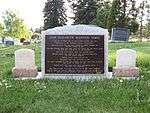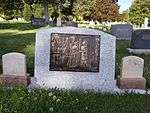Jane Elizabeth Manning James
| Jane Elizabeth Manning James | ||
|---|---|---|
 | ||
| Personal details | ||
| Born |
September 22, 1822 Connecticut, USA | |
| Died |
April 16, 1908 (aged 85) Salt Lake City, Utah | |
| Resting place |
Salt Lake City Cemetery 40°46′37″N 111°51′29″W / 40.777°N 111.858°W | |
| Spouse(s) | Isaac James | |
| Children | 8 | |
| Parents |
Issac Manning Eliza Mead | |
|
| ||
Jane Elizabeth Manning James (September 22, 1822 – April 16, 1908)[1] was an early African-American member of the Latter Day Saint movement who lived with Joseph Smith and his family for a time in Nauvoo, Illinois.
Biography
Jane was the first documented African-American woman to come to the Utah Territory as a Mormon pioneer. With her husband Isaac James, she had eight children. Their daughter Mary Ann was the first black child born in Utah. After Isaac left the family in 1869, Jane repeatedly petitioned the First Presidency to be endowed and to be sealed, along with her children, to Walker Lewis, a prominent African-American Mormon Elder. Lewis, like Elijah Abel, had been ordained to the priesthood during Joseph Smith's lifetime, and Jane therefore assumed that he would be eligible for temple ordinances. However, her petitions were consistently ignored or refused.
After Isaac died in 1891, Jane asked that she and her family be given the ordinance of adoption so that they could be sealed in that manner. Her justification, according to her correspondence with church leaders, was that Emma Smith had offered to have her sealed to the Smith family as a child. She was now reconsidering her decision, and asked to be sealed to the Smiths.
Her request was refused. Instead, the First Presidency "decided she might be adopted into the family of Joseph Smith as a servant, which was done, a special ceremony having been prepared for the purpose."[2] The ceremony took place on May 18, 1894, with Joseph F. Smith acting as proxy for Joseph Smith, and Bathsheba W. Smith acting as proxy for Jane James (who was not allowed into the temple for the ordinance).[3] In the ceremony, Jane was "attached as a Servitor for eternity to the prophet Joseph Smith and in this capacity be connected with his family and be obedient to him in all things in the Lord as a faithful Servitor".[4]
Jane was dissatisfied with that unique sealing ordinance, and applied again to obtain the sealing that was offered to her by Emma. According to the diary of Franklin Richards, the LDS First Presidency met on August 22, 1895, to consider Jane's appeal, but again turned her down. (At this same meeting, they also considered the case of Mary Bowdidge Sojé Berry Smith, "a white Sister who [married] a negro man [and] entreats for permission to receive her ordinances but is refused.")
A few years before her death, James dictated a brief life story to Utah biographer Elizabeth J. D. Roundy, including information on her childhood, religious conversion, interaction with the Joseph Smith family in Nauvoo and with the Latter-day Saints in Utah. The document is held in the Wilford Woodruff Collection in the LDS Church Archives.
Legacy
A 20-minute documentary based on James' life, Jane Manning James: Your Sister in the Gospel, premiered in 2005, and has been shown at This Is The Place Heritage Park in Salt Lake City, Utah, the 2005 annual conference of the Foundation for Apologetic Information & Research (FAIR), and on public television (PBS). The film was directed by Margaret Blair Young, co-author with Darius Gray of the Standing on the Promises trilogy of historical fiction that draws on the facts of James' life. Documentary filmmaker Scott Freebairn produced the film.
In June 1999, a monument to James' life was dedicated near James' grave in the Salt Lake City Cemetery by the Genesis Group (an official organization begun under LDS President Joseph Fielding Smith to support Latter-day Saints of African descent) along with the Missouri Mormon Frontier Foundation. The original headstones of Jane and Isaac James were supplemented with a granite monument faced with two bronze plaques. One side of the monument commemorates an incident documented in 1850, by Mormon pioneer Eliza Partridge Lyman, who wrote:
- April 13: Brother Lyman [Eliza's husband] started on a mission to California with O. P Rockwell and others. May the Lord bless and prosper them and return them in safety. He left us ... without anything to make bread, it not being in his power to get any.
- April 25: Jane James, a colored woman, let me have two pounds of flour, it being about half she had.
A second bronze plaque, containing quotations from James' and significant dates and events from her life, was placed on the back of the monument. In April 2005, the graves and monument were again cleaned and sealed. The inscription on her grave marker reads:


- Jane Elizabeth Manning James
- "I try in my feeble way to set an example for all."
- Born free in 1882 [The marker incorrectly states her birth year. It should say 1822], Fairfield County, Connecticut
- Baptized LDS in 1841, she led a group of family members to Nauvoo, Illinois in 1843
- "Our feet cracked open and bled until you could see the whole prints of our feet with blood on the ground."
- Jane lived with Joseph, Emma and Mother Smith
- "Brother Joseph sat down by me and said, 'God bless you. You are among friends."
- Married Isaac James around 1845
- Arrived in Salt Lake September 22, 1847
- "Oh how I suffered of cold and hunger, but the Lord gave us faith and grace to stand it all."
- Shared half her flour with Eliza Partridge Lyman, who was near starving.
- Died April 16, 1908, outliving all but two of her eight children.
Notes
- ↑ "Death Certificate". State of Utah. April 17, 1908. Retrieved December 14, 2009.
- ↑ "Excerpts from the Weekly Council Meetings of the Quorum of Twelve Apostles, Dealing with the Rights of Negroes in the Church, 1849-1940". George Albert Smith Papers (University of Utah).
- ↑ Quinn, D. Michael (1997). The Mormon Hierarchy: Extensions of Power. Salt Lake City: Signature Books. p. 795. ISBN 1-56085-060-4.
- ↑ Salt Lake Temple Adoption Record: Book A. May 18, 1894. p. 26.
References
- James, Jane E. Manning. Transcribed by Elizabeth J. D. Roundy. "My Life Story". Wilford Woodruff Papers (Salt Lake City, Utah: Historical Department, The Church of Jesus Christ of Latter-day Saints).
- Mueller, Max (Winter–Spring 2011). "Playing Jane: The history of a pioneer black Mormon woman is alive today". Harvard Divinity School Bulletin 39 (1 & 2).
- Newell, Linda King; Avery, Valeen Tippetts (August 1979). "Jane Manning James: Black Saint, 1847 Pioneer". Ensign (Salt Lake City, Utah: LDS Church).
- O'Donovan, Connell (2006). "The Mormon Priesthood Ban & Elder Q. Walker Lewis: ‘An example for his more whiter brethren to follow’". John Whitmer Historical Association Journal. (Online reprint with author updates)
- Smith, Becky Cardon (2005-04-15). "Remembering Jane Manning James". Meridian Magazine. Archived from the original on 2010-02-06.